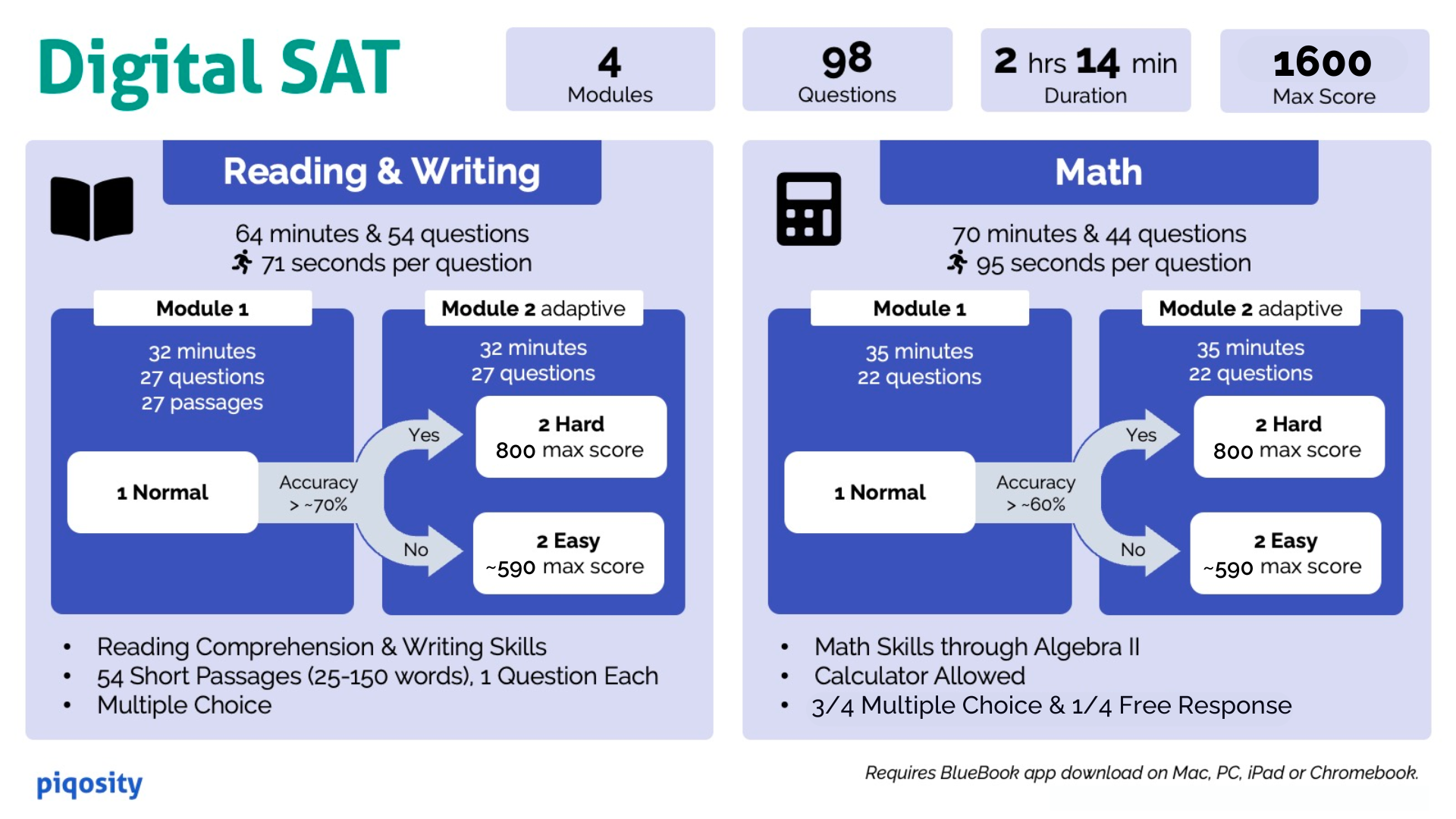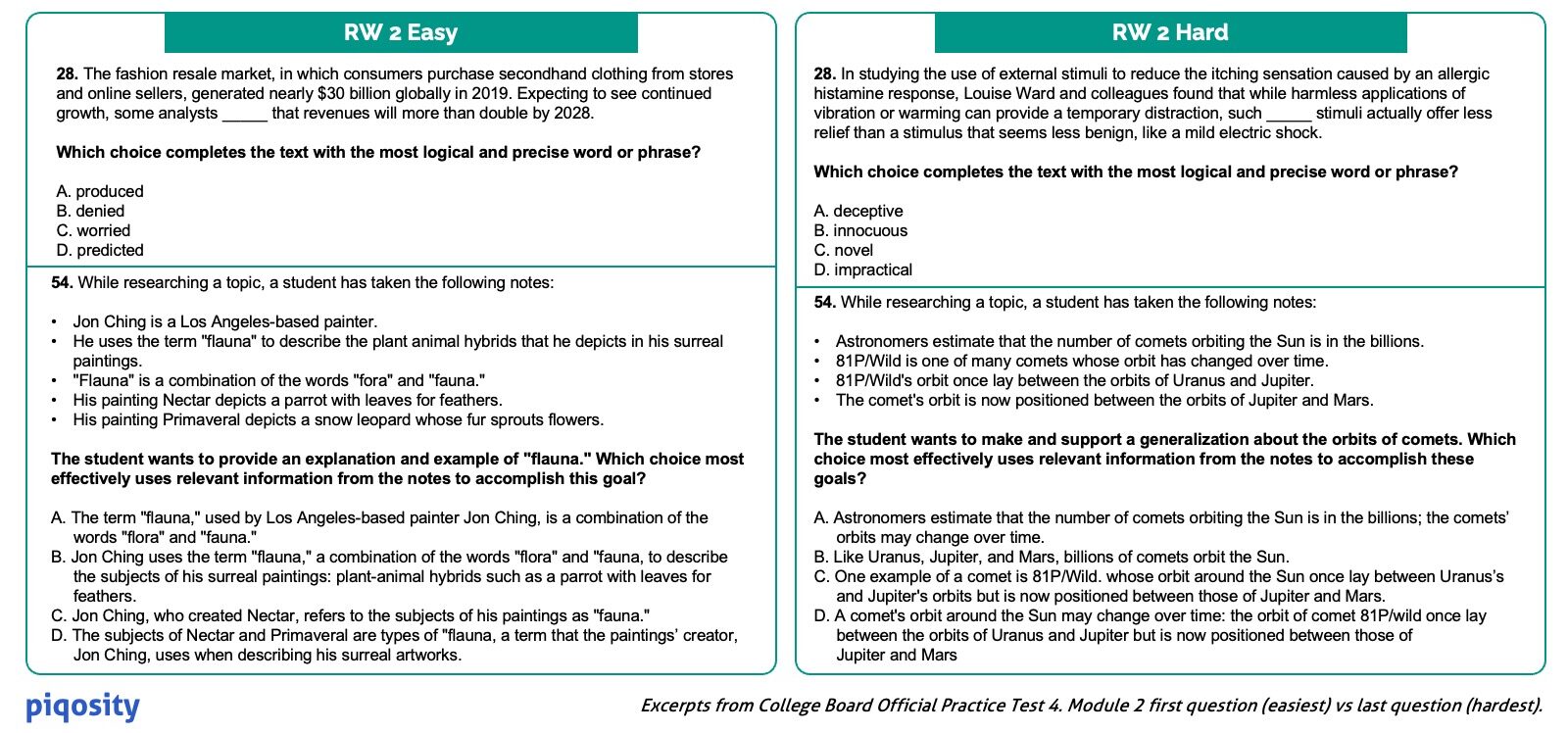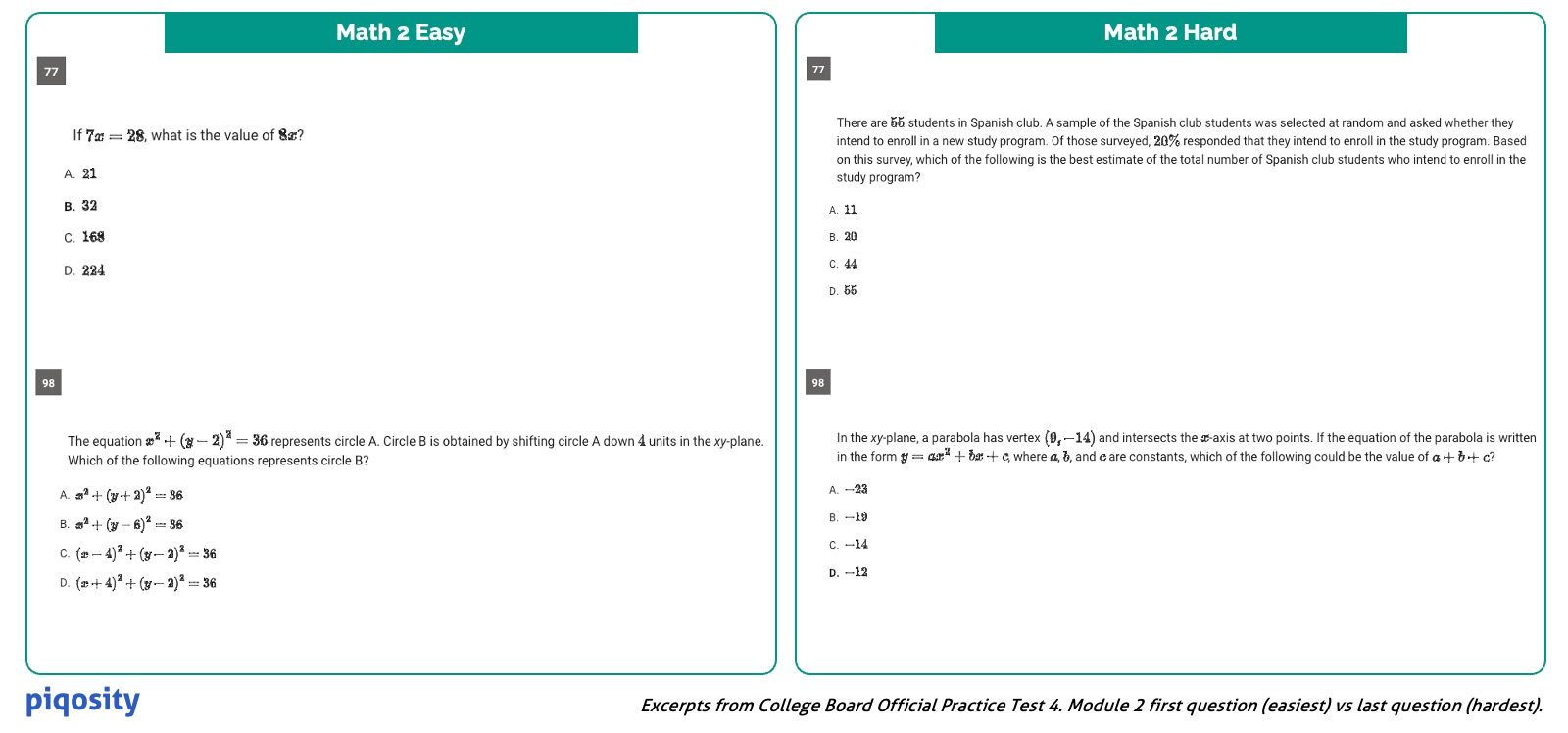
Nearly 100 years after the SAT was first administered, the College Board has just implemented a major makeover for its widely used college admissions exam. This all-new Digital SAT format, now made up of “modules” that adapt to students’ in-test performance, will fully replace the current SAT in 2024.
The last change to the SAT in 2016 removed several aspects of the exam that made it more difficult to take: penalties for incorrect answers, the mandatory essay section, and extra answer options for multiple choice questions. Likewise, this year’s SAT changes have been implemented to better fit the needs of today’s high schoolers and, thus, more effectively measure their math and ELA reasoning skills.
The New Digital SAT Format: What’s Changing?

In the wake of recent criticisms of college entrance exams that question whether or not they still matter, it’s clear that the College Board decided to implement its SAT renovation now to maintain the test’s relevance as a measure of student knowledge and college readiness. So, what are the specific changes, and how do they improve the test-taking process?
The most substantial update is that the SAT is now fully digital, which means that students can take it on their own (approved) devices—so long as they download the Bluebook app ahead of time. Note that fully remote SAT testing is not available, so students must still take the exam in a testing center. This shift from paper to screen mirrors schools’ increasingly online curricula and comes with all the benefits of online testing, such as allowing fewer opportunities for cheating and streamlining the administration and grading process. (Students will now get their scores sooner than ever before!)
The digital SAT structure is also significantly shorter. The previously-separate reading and English sections have been combined into one “Reading and Writing” test, and the “No Calculator” and “Calculator” math portions are now a single, calculator-permitted math test. Plus, page-long reading passages for reading and English questions have been replaced with paragraph-length mini-passages, increasing the likelihood that students will stay concentrated and engaged with the test material.
| Time Allotted | Number of Questions | |
|---|---|---|
| Reading and Writing | 64 minutes (two 32-minute modules) | 54 (27 per module) |
| Math | 70 minutes (two 35-minute modules) | 44 (22 per module) |
| Total | 134 minutes (2 hours 14 minutes) | 98 |
The final significant change to the SAT as a whole is: students won’t all be taking the same test. In fact, some students will have an easier test than others. Don’t be too bewildered—the use of “modules” has allowed the College Board to deliver a more personalized and accurate SAT experience.
What are SAT Modules?
Since the SAT is now digital, the test can be modified in ways that aren’t possible for a physical, paper test. One major change to the exam is its division into modules, which let the exam adapt to individual students’ capabilities—as opposed to the “one-size-fits-all” approach of the ACT and the previous versions of the SAT.
Each section of the digital SAT format is composed of two equal-length modules—so, Reading & Writing has two (32-minute, 27-question) modules, and Math has two (35-minute, 22-question) modules. A student’s performance on the first module determines what kind of second module they get.
Adaptive testing, which describes tests that change based on the test-taker’s accuracy, allows for a more accurate and fairer exam experience because it’s more personalized, taking student ability into account when administering and scoring the exam. Testers also have a better experience taking an exam that fits their skill level. Students who struggle with SAT content are presented with a second module that isn’t overwhelmingly difficult, while students who excel aren’t spending too much time on questions that are too easy.
Let’s cover what to expect from the different types of modules on this Digital SAT format and how the scoring takes difficulty into account.
The “Normal” Module 1
Module 1 of each Digital SAT section is nearly the same* for every tester on that day and consists of a mixture of easy, medium, and hard questions from all topics. In the Math section, questions are arranged from easiest to hardest; similarly, in the Reading and Writing section, questions that test similar knowledge are grouped and arranged from easiest to hardest. This transparency with difficulty and content topics is provided in order to allow students to budget their time accordingly, giving them the best opportunity to demonstrate what they know.
A tester’s performance on Module 1 results in an invisible, temporary “score” that the Digital SAT software uses to determine which Module 2 is administered.
* According to College Board’s Assessment Framework for the Digital SAT Suite, each student taking a Digital SAT exam “… is administered a highly comparable but unique version of the test.” This means that you and your peers won’t have an identical Module 1, but your respective versions will be very similar.
The “Adaptive” Module 2
Because the second module is dependent on a student’s Module 1 performance, there are multiple versions of Module 2: an easy version (which we’ll refer to as Module 2A) and a hard version (Module 2B). If a student gets roughly two-thirds of the Module 1 questions correct, they will be administered Module 2B for the next portion of the test. If they don’t get about two-thirds correct, they’ll get Module 2A.
How do these modules compare? First of all, questions from all of the test’s content domains are present on all modules. For example: even though Advanced Math is an objectively more complex topic than Algebra, all math modules will have roughly the same amount of Advanced Math questions. When we discuss differences in difficulty, that comes from individual question difficulty. So, you’ll see the same topics no matter which module you get—those topics will just be tested through more difficult questions if you’re administered Module 2B.
As you expect, Module 2B is the most difficult of the three modules. Module 2A is easier than both Module 2B and Module 1. Though each module has a mixture of easy, medium, and hard questions, Module 2A has a greater quantity of easy questions while 2B has more hard questions.
Modules and Test Scores
How does module difficulty affect scoring? Since it’s unfair to use the same scoring for students who took exams of different difficulties, SAT scores now take into account which second module a student receives. This means that there is a cap on how high a student’s score can be if they are given Module 2A—even if they answer every question right on it. If a student gets Module 2A for a section of their SAT (whether Math or Reading and Writing), their score for that section is capped at around 590.
So, don’t purposefully miss more questions on Module 1 in hopes of getting the easier module—you won’t be able to break 600 points for that portion of the exam!
How does the SAT Reading and Writing Hard Module Compare to the Easy Module?
Let’s look at an actual example from the College Board’s official practice test 4 for Reading and Writing test. The image below shows the first and last question of the easy module versus the first and last question of the hard module. Can you tell the difference?
Question 28, the first question of the second Reading and Writing module, is a vocabulary-in-context question on both the easy and hard modules.
- The easy module question is only 38 words in length vs 55 for the hard module (nearly 45% more reading!)
- The subject matter of the easy module question (shopping) is likely more easy to understand than the hard module (scientific study)
- The vocabulary word tested is simpler on the easy module (predicted vs innocuous)
Question 54, the last question of the module, asks the student to summarize the points provided on both the easy and hard modules.
- The subject matter of the easy module is probably easier for students to understand (paintings) vs the hard module (comets)
- Similarly, the language of the easy question is simpler versus the scientific terminology in the hard question
- The easy question task is more basic and less encompassing—define a word versus summarize key points
How does the SAT Hard Math Module Compare to the Easy Math Module?
Now, let’s consider an actual example from the College Board’s official practice test 4 for the Math Test. The image below shows the first and last questions of the easy module versus the first and last questions of the hard module. Can you see the differences?
Question 77, the first question of the second Math module, is a basic computation in both the easy and hard modules, but look at how many words there are in that hard module question! The hard module forces you to sort through 72 words just to calculate 20% of 55!
Question 98, the last question of the second Math module, expects you to know some special formulas. For the easy question, you just need to know the formula of a circle and then you’ve basically got your answer. For the hard question, you need to find the equation for the parabola taking into account both solutions, which is much more complex and step-intensive.
How to Prepare for the Digital SAT
If the new digital SAT format is on your horizon, we hope you now understand how the modules work! The test-taking process for this new SAT is designed to be easier to take, which should let your knowledge and months of preparation shine. If you’re looking for a digital SAT practice test that can help you get accustomed to this new adaptive format, Piqosity is here to help!
Along with our full-length, online ELA and Math courses for grades 5-11, we offer full SAT, ACT, and ISEE test prep courses, each of which includes 12 practice exams, dozens of concept lessons, personalized practice software, and more. In addition to our upcoming digital SAT course, we’re also offering digital SAT practice tests! This practice Digital SAT is designed to help you prep ahead of time for the exam’s new format, available by signing up for a Piqosity community account.





Hello! I am wondering if you can tell me if you can SKIP a question and come back to it later on the digital SAT. Thanks!
Yes, in both Piqosity and the official Blue Book App, you can skip any question and come back to it within the *same* module so long as time allows.
Is there a chance that a student who barely makes (and gets crushed by) module 2B will get a lower score than a student who barely misses 2B but aces 2A? Is there NO OVERLAP WHATSOEVER in the potential score ranges for 1>2A and 1>2B? Any insights?
Hi Nick, it would be very unlikely but not wholly impossible for an easy module student to surpass a hard module one.
After analyzing hundreds of practice tests on the Blue Book App, we saw that students generally earn 10 points for every correct answer. But they get a ~130 point bonus when they answer enough questions to make it to the harder module.
So some rough calculations that obviously don’t take into account the exact norm group:
– The minimum score for a student who makes it to the harder module by 1 question but answers 0 harder module questions correct is ~450.
– A student who barely misses the cutoff for the harder module could theoretically get a higher score by answering at least 12/22 questions correctly in the easier module 2a, which would give them a score of ~450.
We definitely don’t think it’s a good strategy to “miss the hard module” and “ace the easy module”. There’s no way to know exactly how many questions a student would need to get right, and they’d be aiming to score no higher than ~550.
Hello, I’m wondering if the digital SAT module 2 is also unique for each individual as it is noted for module 1? As in, will each person taking the harder module 2 receive the same version? Or will it vary slightly?
Hi Gabriel, just like with the old paper SAT, College Board indicates that even students sitting right next to each other in the same classroom could have a different version of the test. This is done to inhibit cheating and why each test also is shown with a “scaled score.” Scaled scores are what enable the test maker to norm the test and fairly apply scores even if students are technically taking different variations of a test.
Hello, it seems I keep getting the easier 2nd module. I’d like to know how I can get the harder 2nd module? Does it depend on how many questions I get right on the 1st module? If so, how many questions should I do correctly?
Hi Didi, getting to the hard second module does depend on how many questions are answered correctly on the first module of each section. For the Reading and Writing section, students will need to answer about 70% of questions in the first module (about 15-17 questions) correctly in order to reach on the hard second module, and on the Math section, they will need to answer about 60% of the questions on the first module (about 12-14 questions) correctly in order to reach the hard second module. If these thresholds aren’t met, students will end up in the easy second module instead of the hard one.